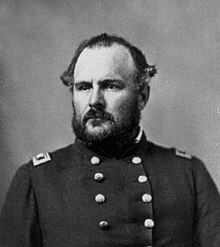3rd Colorado Cavalry Regiment
This article has multiple issues.Please helpimprove itor discuss these issues on thetalk page.(Learn how and when to remove these messages)
|
| 3rd Colorado Cavalry Regiment | |
|---|---|
 The unit at theSand Creek massacre | |
| Active | August 20, 1864 – December 31, 1864 |
| Disbanded | December 31, 1864 |
| Country | |
| Allegiance | |
| Branch | Cavalry |
| Garrison/HQ | Denver,Colorado |
| Nickname(s) | Bloodless Third |
| Engagements | American Civil War |
| Commanders | |
| Notable commanders | ColonelGeorge L. Shoup ColonelJohn M. Chivington(as District commander) |
The3rd Colorado Cavalry Regimentwas aUnion Armyunit formed in the mid-1860s when increased traffic on the United States emigrant trails and settler encroachment resulted in numerous attacks against them by theCheyenneandArapaho.TheHungate massacreand the display inDenverof mutilated victims raised political pressure for the government to protect its people.GovernorJohn Evanssought and gained authorization from theWar DepartmentinWashingtonto found the Third. More a militia than a military unit, the "Bloodless Third" was composed of "100-daysers," that is, volunteers who signed on for 100 days to fight against the Indians. (Its nickname came from its lack of battle experience.) The unit's only commander was Col.George L. Shoup,a politician from Colorado.[1][2]The regiment was assigned to the District of Colorado commanded by Col.John M. Chivington.
Early Operations
[edit]
At theCamp WeldCouncil of September 28, 1864, Evans and Chivington met with five chiefs, includingBlack Kettleof the Cheyenne andWhite Antelopeof the Arapaho. They had been brought to Denver to parlay for peace under military escort by MajorEdward W. Wynkoop,commander ofFort Lyon.The chiefs agreed to peacefully settle their people on the reservation on Big Sandy Creek about 40 miles northwest of Fort Lyon. The reservation was created under theFort Wise Treatyof 1860. With Wynkoop's assuring their safety, the chiefs settled their bands in a large village at the curve of Sand Creek. Some Indians set up lodges closer to Fort Lyon.
On November 5, Major Wynkoop was removed from command and replaced by an ally of Chivington, Major Scott Anthony. He ordered all Indians camped around the fort to the reservation. On November 26, Wynkoop departed for reassignment toFort Riley,Kansas.
On November 28, Chivington arrived at Fort Lyon, having traveled in great secrecy with 700 Third Colorado Cavalry and a battalion of the First Colorado Cavalry.[3]Encouraged by Governor Evans and spurred by his own ambitions, Chivington felt pressure to use the "Bloodless Third" before the volunteers' terms expired. He sealed off the fort. Officers loyal to Wynkoop were held at gunpoint. That night, reinforced by artillery from the fort and 125 troops of the First Cavalry, Chivington set off for the Cheyenne-Arapaho village at Sand Creek.
Sand Creek massacre
[edit]Arriving at dawn on November 29, 1864, the volunteer cavalry attacked. Although Black Kettle had flown an American flag on his tipi to signal peace (as directed by Wynkoop), the volunteers killed indiscriminately. Historians have not agreed on the number killed, but they often cite 150, mostly women and children, as the warriors had gone out on a hunt. The cavalry mutilated some of the corpses, taking body parts as souvenirs.
Now called the "Bloody Third," the regiment returned to Denver in December. It mustered out on December 31, 1864. For months the men displayed the body parts as trophies in Denversaloons.Although Chivington and his forces were lauded by many at the time for a heroic "battle," critics complained about the military conduct of the men.[4]
Aftermath
[edit]TheUS Congressinvestigated the attack. The hearings were widely covered, leading to national shock and outrage about the brutality of the attack and the betrayal of promises made to the Cheyenne and Arapaho. Because the Native Americans believed the Cheyenne had been targeted by the US, majorSiouxand Arapaho bands allied with them from 1865 on to attack theVehos(whites) and try to drive emigrant settlers out of their lands.
See also
[edit]References
[edit]- ^All biographies
- ^Sand Creek
- ^"The Indian War, 2 Jun 1867, Page 8 - The New York Times at Newspapers".Newspapers.p. 8.Retrieved7 December2017.
- ^Laura King Van Dusen,Historic Tales from Park County: Parked in the Past(Charleston,South Carolina:The History Press, 2013),ISBN978-1-62619-161-7,p. 33.
- Bibliography
- Hoig, Stan,The Sand Creek Massacre(Univ of Oklahoma Press, 1961).
- Hyde, George E.The Life of George Bent, Written from his Letters.Univ. of Oklahoma Press, 1968.
- 38th Congress, Second Section,Massacre of Cheyenne IndiansWashington, DC, 1865. (transcript of the investigation).
- Wynkoop, Edward.The Tall Chief: Autobiography of Edward W. Wynkoop.Ed. by Christopher Gerboth. Colorado Historical Society, 1993.
External links
[edit]- "Sand Creek Massacre Historic Site",National Park Service
- "Historic Documents",The West,PBS; see John S. Smith testimony to Congress
- 1864 disestablishments in the United States
- Units and formations of the Union Army from Colorado
- History of Colorado
- Military units and formations of the United States in the Indian Wars
- Arapaho
- Cheyenne
- 1864 establishments in Colorado Territory
- Military units and formations established in 1864
- Military units and formations disestablished in 1864
